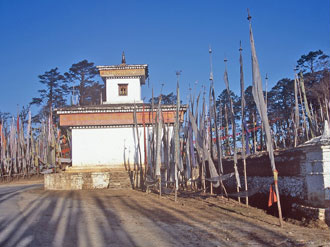When to go
 The four distinctive seasons in Bhutan show off the country and the life of its farmers in four distinct hues. And a drive from South to North covers a wide range of temperatures and altitudes. The contrast is overwhelming: an eight-hour drive starting in the south would take you from the heat of the South Asian lowlands, to a comfortable Mediterranean-like climate one hour later, a cool temperate climate within four hours, and a chilly Siberian climate on the high passes in the North.
The four distinctive seasons in Bhutan show off the country and the life of its farmers in four distinct hues. And a drive from South to North covers a wide range of temperatures and altitudes. The contrast is overwhelming: an eight-hour drive starting in the south would take you from the heat of the South Asian lowlands, to a comfortable Mediterranean-like climate one hour later, a cool temperate climate within four hours, and a chilly Siberian climate on the high passes in the North.
The northern part of Bhutan is generally high, cool and cold and the southern part is lower, warm and hot. Geographically Bhutan is divided into three areas: tropical in the south, temperate in the centre and alpine in the north. All these areas offer distinct flora and fauna which is one of the charms for those who visit Bhutan.
Spring
Spring begins in late February with local festivities when the first signs of life pop up from the ground. In no time, the colour of the peach, apple, mustard, magnolia, wild cherry and rhododendrons brightens the whole country. The farmers plough their fields for the new season preparing to grow corn, millet, buckwheat, chillies, potatoes and rice, manually or with oxen. In the western part of Bhutan you will see small tractors but as you travel to the east farmers still practice the same age-old tradition, pair of their hands. The beginning of the spring season is hazy but towards the end of spring, if the weather permits, you will have wonderful clear skies and mountain views.
Summer
The rainy season begins around late June and lasts until mid September. Summer is wet but humidity is low. The “green season” as I refer to it, is the perfect time to see Bhutan, since it is really green and there is a great opportunity to study plants and insects. Mother Nature revels in colour and, for the farmers, it is the busiest time of the year. It is also the time of the year when Bhutan is hidden in among the clouds and the Land of the Thunder Dragon really roars. The swollen rivers gushing down, small and big flowing directly from the base of the Himalayan Mountains snaking through the small mountains are part of the character of the country that ultimately flows into the Bay of Bengal. If you are visiting in summer it is also part of the adventure and very few visitors seen at that time of the year.
Autumn
Autumn begins with the blossom of cosmos and change of clours in leaves. The burst of atoms in the leaves from the sudden severs cold is another scene. The celebration of Blessed rainy day, officially the rain stops just like the tap water and the merry making season begins. It is also the peak season for the tourism and tourist gather from all over the globe to see some of the well known festivals in Thimphu, Wangdi, Bumtha,Mongar and Trashigang.It is also the time for the farmers to harvest their
crop, in the fields you will see farmers singing, dancing and dirking locally brewed colorless liquor called Ara. Towards the end of the autumn the fields turn into brown, herds of cows gather from their summer grazing and the cow herders blowing flute perhaps to the cows or he is singing for being lonely. The houses roofs are bright red, drying chilies and other winter vegetables. The weather is superb and the views of the eastern Himalayas are out of this world. The night is another joy for those who are into star gazing- Away from Thimphu you can take a night walk near by any of the hotel or lodge, listening to the rustling sound of the leaves, freshly fallen from the trees on the ground and above zillion stars gazing directly upon you and the shooting (hunting) stars disappearing momentarily just like our life!
Winter
In the near future the Government is planning to open the southern part of Bhutan and it will be idle for jungle safari in the Manas Wildlife sanctuary. The weather is warm and unlike summer infested with leech and other biting insects, it is free from the blood sucking insects in winter.Dry and pleasant conditions make this the best time of year for bird watching in the jungles, some birds migrational and some are native migrating from the alpine areas to the sub-tropical.
We are also planning to lead a winter trek in the lower altitudes, walking from village to village and visit some local peopleor a bicycle trip along quiet mountain roads.. Following the age-old hiway is interesting because it used to be the national highway before the motor roads came to Bhutan. If you are interested in studying a threatened bird species called black-necked crane, indeed it is the season. Winter is off season and very few visitor at this time of the year.
